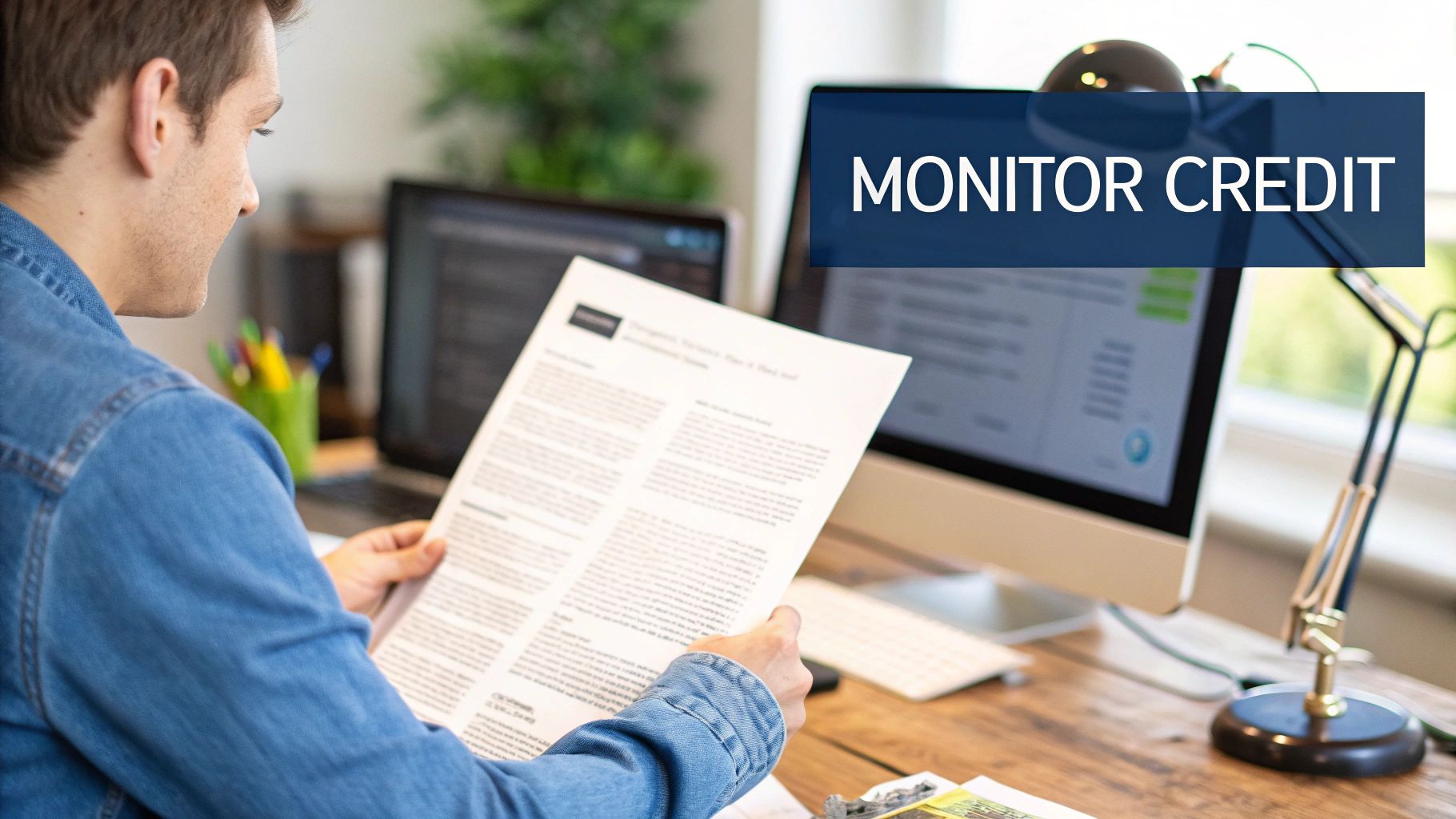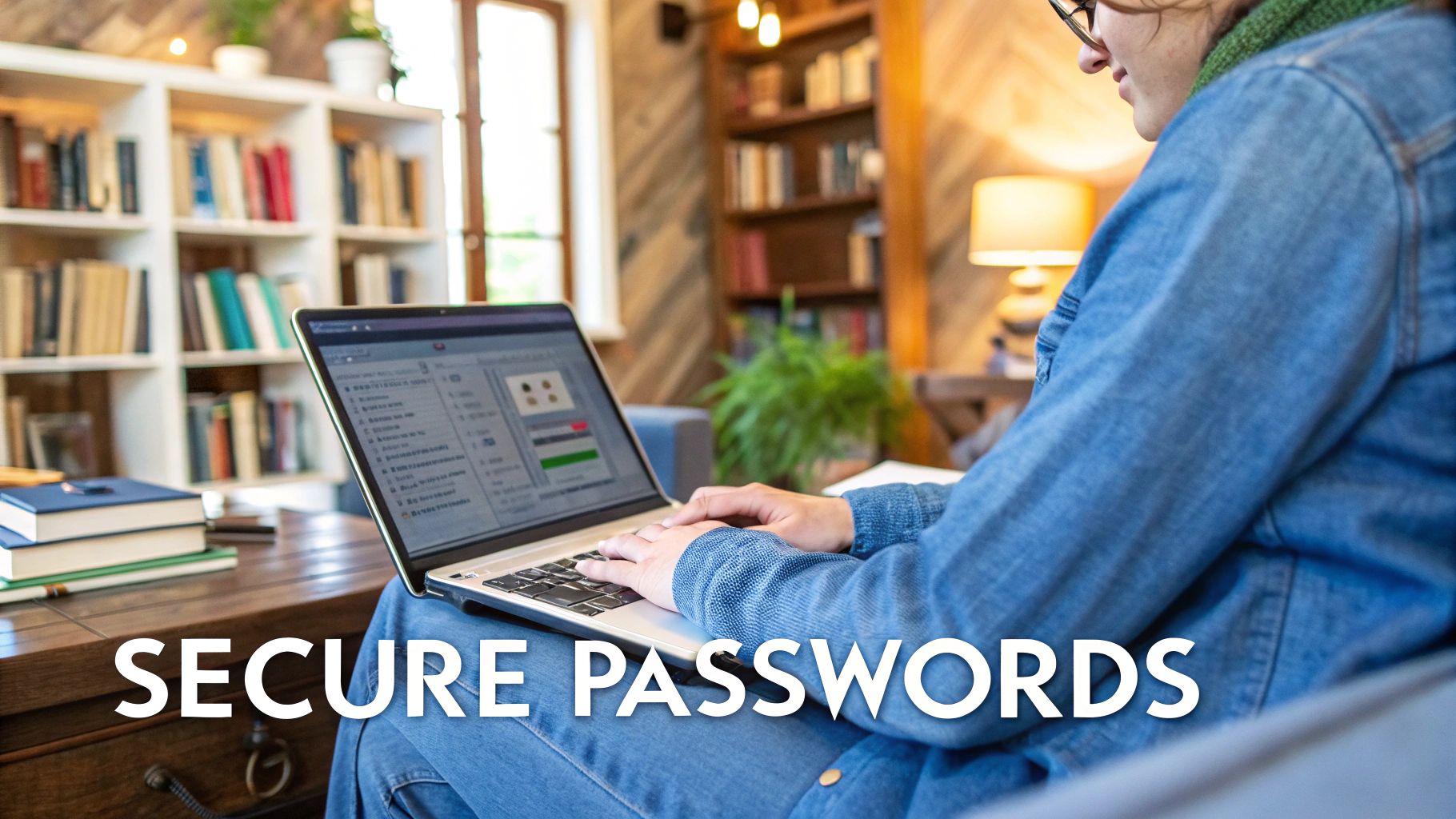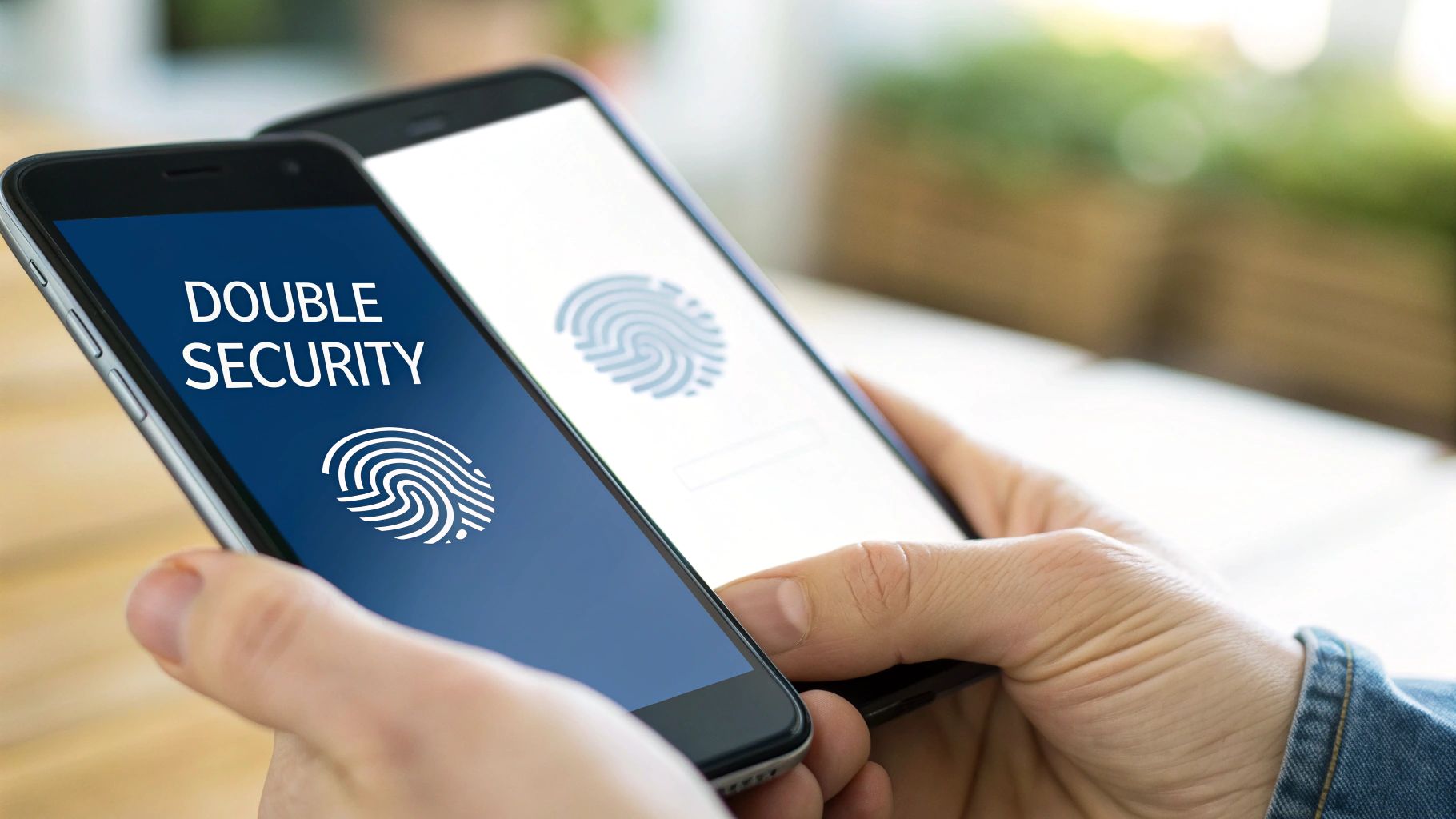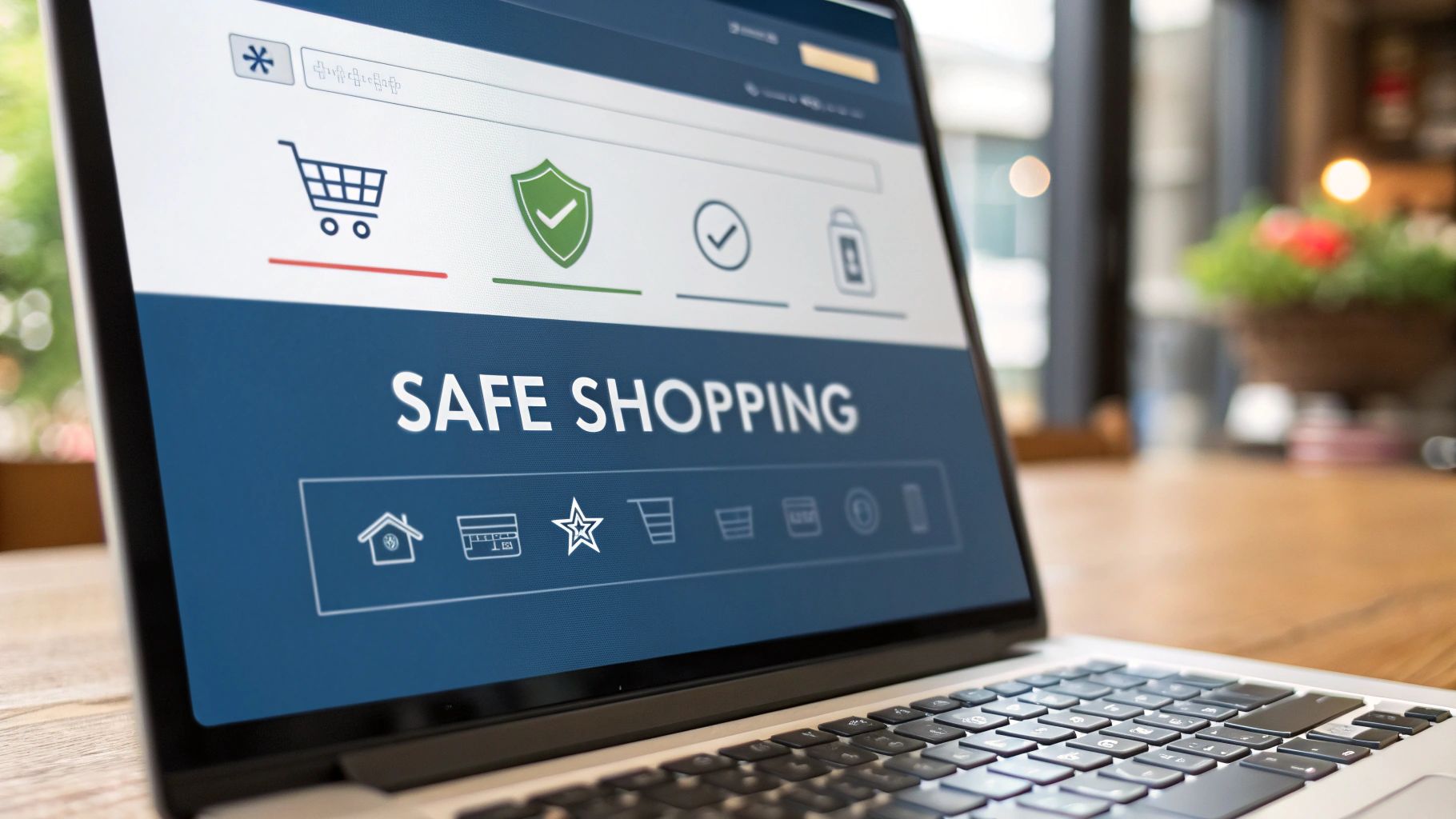How to Prevent Identity Theft: Your Complete Protection Guide
Understanding the Modern Identity Theft Landscape

Identity theft has grown far beyond simple credit card fraud into a complex threat affecting millions of Americans each year. According to the U.S. Department of Justice, 23.9 million people aged 16 or older experienced identity theft in 2021 alone – that's 9% of the adult population. Even more concerning, about 1 in 5 Americans (22%) have fallen victim to identity theft at some point in their lives. These numbers paint a clear picture of just how widespread this crime has become. For more details, see the full report from the Bureau of Justice Statistics.
New Avenues of Attack
Thieves are finding increasingly sophisticated ways to steal personal information. One emerging threat is synthetic identity theft, where criminals piece together new identities by combining real and fake information – making detection much harder. We're also seeing more account takeover fraud, where thieves gain direct access to existing accounts through phishing scams, data breaches, or malware. This gives them complete control over both finances and personal data.
Who Is at Risk?
While identity theft can happen to anyone, certain groups face higher risks. Seniors are frequent targets since they may be less familiar with online security or more vulnerable to scams. But even young, tech-savvy people regularly fall victim to well-crafted phishing attacks and data breaches. The reality is that everyone needs to stay alert and informed about identity theft risks.
Beyond Traditional Protection
While basic precautions like shredding documents and checking credit reports still matter, they're no longer enough on their own. Modern identity theft requires modern solutions – from using strong passwords and two-factor authentication to staying informed about the latest scams and security threats. The key is taking a comprehensive approach that combines old-school vigilance with new digital safeguards.
Building Your Credit Security Fortress
Think of your credit identity like a house – it needs solid protection and regular maintenance to stay secure. One of the most effective ways to prevent credit fraud is implementing a credit freeze. This essential security tool stops unauthorized access to your credit reports, making it nearly impossible for thieves to open accounts in your name.
Here's how it works: If someone tries using your stolen information to get a credit card, the lender won't be able to pull your credit report due to the freeze. Without access to your credit history, they'll deny the application. To get full protection, you'll need to set up freezes with all three major credit bureaus – Equifax, Experian, and TransUnion. Learn more about credit freezes and identity theft prevention on NerdWallet's guide.
Setting Up Credit Freezes
Don't let the process intimidate you – freezing your credit is straightforward. Each bureau provides online portals and phone support to help you set up and manage your freeze. You'll verify your identity with some personal information, and the freeze takes effect quickly.
The process for each bureau works like this:
- Equifax: Access their website or call their support line
- Experian: Use their online portal or phone service
- TransUnion: Set up through their website or by phone
When you need to apply for credit, temporarily lifting the freeze is simple. You can specify how long to allow access, and the freeze automatically reactivates afterward.
Credit Monitoring: Your Early Warning System
While freezes prevent unauthorized access, credit monitoring services act as your lookout. These tools scan your credit reports and notify you about new accounts, credit checks, or suspicious changes. This gives you time to respond quickly if something seems wrong.
Picking the Right Monitoring Service
Credit monitoring options range from basic alerts to full security packages. Consider which features matter most based on your situation and concerns.
| Feature | Basic Service | Premium Service |
|---|---|---|
| Credit Report Alerts | Yes | Yes |
| Inquiry Alerts | Yes | Yes |
| Identity Theft Insurance | No | Often Included |
| Dark Web Monitoring | No | Sometimes Included |
Many banks and credit card companies now include free monitoring tools with their accounts. These make a good starting point and work well alongside more complete paid services. By combining strong credit freezes with active monitoring, you create a solid defense system for your financial identity. This two-part approach helps you spot and stop potential threats before they cause serious damage.
Mastering Digital Security Essentials
Protecting yourself from identity theft requires taking specific steps to secure your personal information. Just like you lock your doors at night, you need to build strong digital defenses around your sensitive data. Let's explore the key practices that help prevent identity theft in our connected world.
Strong Passwords and Multi-Factor Authentication
Your password acts like a key to your digital life – the stronger and more unique it is, the harder it is for thieves to break in. Multi-factor authentication (MFA) adds an extra security barrier, similar to having both a lock and an alarm system on your front door. Even if someone gets your password, they can't access your accounts without the second verification step.
Two-factor authentication (2FA) specifically requires two things: something you know (your password) and something you have (like your phone for verification codes). This combination makes it much more difficult for criminals to compromise your accounts. Learn more about protecting your identity on Aiprise's blog.
Secure Your Home Network and Devices
Think of your home Wi-Fi network as the fence around your digital property. A weak or unsecured network makes it easy for intruders to slip in and access your connected devices. Setting up a strong Wi-Fi password and enabling encryption helps keep unwanted visitors out.
Your devices need regular maintenance too. Software updates often fix security flaws that hackers could exploit. Making these updates a priority, whether on your computer, phone, or other connected devices, helps close potential entry points for identity thieves.
Recognizing and Avoiding Scams
Spotting online scams is a vital skill in preventing identity theft. Criminals often create convincing fake emails, websites, and ads that look like they're from real companies. For example, you might get an email that appears to be from your bank asking you to "verify" your account details. Stay safe by always checking email addresses carefully, hovering over links before clicking, and being skeptical of unexpected requests for personal information.
Evaluating Security Tools
When choosing security tools, focus on substance over flash. Look for proven antivirus software, password managers, and VPNs with solid track records and positive user feedback. Skip products making grand promises without evidence to back them up. Taking time to research and select quality security tools gives you real protection rather than false confidence.
Developing Your Early Warning System
Protecting yourself from identity theft requires a proactive early warning system. Rather than scrambling to fix issues after they occur, you need a combination of smart monitoring tools and regular personal checks to catch problems early. This approach helps you spot suspicious activity quickly and take action before major damage occurs.
Recognizing the Warning Signs
Most identity theft starts with subtle clues that are easy to miss. Common early warning signs include getting bills for accounts you never opened, seeing unfamiliar charges on your credit cards, or having loan applications unexpectedly denied. You should also pay attention if you receive calls or emails about accounts that aren't yours. While these may seem like minor annoyances, they often signal the beginning of identity theft.
Setting Up Account Alerts
Your bank and credit card companies offer alert systems that can be your first line of defense. Set up notifications for things like password changes, logins from new devices, and large purchases. For example, if someone tries to change your password without your knowledge, you'll know immediately and can secure your account. These real-time alerts give you the power to stop theft attempts before they succeed.
Regular Identity Monitoring: A Practical Approach
Creating simple monitoring habits protects you for the long run. Start by checking your bank and credit card statements each month for strange charges. Make time to review your credit reports regularly too. Quick detection makes a big difference – the Federal Trade Commission found that when victims caught identity theft within 5 months, 67% had zero out-of-pocket costs.
Combining Automation with Manual Checks
While automatic alerts are helpful, don't rely on them completely. Take time to personally review your accounts and credit reports to catch issues that automated systems might miss. Think of it like home security – you want both an alarm system and regular visual checks to stay fully protected.
Taking Action When Something Seems Wrong
When you notice anything suspicious, act quickly. Call your bank or credit card company right away to report the problem and freeze affected accounts. You should also file a police report and consider placing a fraud alert with credit bureaus. Fast action limits how much damage identity thieves can do. By staying alert and using the right mix of monitoring tools, you create a strong early warning system that helps prevent identity theft from becoming a major crisis.
Safeguarding Your Physical Information Trail
Physical documents like birth certificates and Social Security cards need just as much protection as your online information. While many focus heavily on cybersecurity, physical documents remain a prime target for identity thieves. Taking steps to secure these materials is essential for complete identity protection.
Understanding the Physical Targets
Identity thieves often pursue physical documents because they provide concentrated personal data in one place. A single stolen wallet can give criminals access to your driver's license, credit cards, and potentially your Social Security card – everything needed to commit fraud in your name. They also frequently target discarded mail to obtain bank statements, credit offers, and other sensitive materials.
Secure Storage Solutions
The best defense starts with proper storage. While a high-security safe is great, even a basic locked file cabinet works well for many documents. For critical items like birth certificates and Social Security cards, consider using a fireproof and waterproof safe or bank safety deposit box.
Here's a simple guide for storing different documents:
- Vital Records (Birth Certificates, Social Security Cards): Safe or safety deposit box
- Financial Documents (Bank Statements, Tax Returns): Locked file cabinet
- Medical Records: Secure storage with digital backup copies
- Passport: Safe or other secure home location
Safe Disposal Practices
Never just throw sensitive documents in the trash. Identity thieves often search through garbage to find personal information. Instead, use a cross-cut shredder to destroy any papers with personal details before disposal. This includes junk mail, credit card offers, and expired documents. For extra security, mix shredded papers with regular trash to make reconstruction even harder.
Security on the Go
Traveling creates unique document security challenges. Keep your Social Security card at home unless absolutely necessary. Use hotel room safes for valuable documents and electronics when available. If carrying sensitive materials, keep them close and stay alert. Consider using a money belt or secure inner pocket to protect important papers.
These practical steps create strong protection against physical identity theft. When combined with good digital security practices, you build a complete defense system. Remember that effective protection requires addressing both physical and online vulnerabilities.
Taking Control: Your Identity Theft Recovery Blueprint
Finding out you're a victim of identity theft is scary, but quick action can limit the damage. Let's walk through exactly what you need to do to protect yourself and recover.
Immediate Steps to Take
The first 24-48 hours after discovering identity theft are critical. Start by calling any companies where fraud occurred – for example, if someone used your credit card, contact your card issuer right away to report unauthorized charges and freeze the account. This stops further fraud and creates an official record.
Your next move is placing a fraud alert with one of the major credit bureaus – Equifax, Experian, or TransUnion. This alert tells creditors they need to verify your identity before opening new accounts. You only need to contact one bureau since they're required to notify the others.
Documenting and Reporting the Incident
Good records are essential for recovery. Keep detailed notes of every conversation, including:
- Who you spoke with
- Date and time
- What was discussed
- Any case numbers or reference codes
- Copies of fraudulent documents
File an official identity theft report at IdentityTheft.gov. The site will create a personalized recovery plan and give you an official report. Also file a police report – having both FTC and police reports strengthens your case when working with banks and creditors.
Working with Financial Institutions and Credit Bureaus
Send copies of your identity theft report and police report to your banks and the credit bureaus. Be specific about which charges or accounts are fraudulent and request they be removed from your records. Follow up regularly until issues are resolved. Keep copies of all correspondence and note who you speak with.
Restoring Your Identity and Preventing Future Theft
Recovery takes time. Work through each fraudulent charge and account systematically:
- Close compromised accounts
- Dispute unauthorized charges
- Fix credit report errors
- Follow your FTC recovery plan
Once immediate issues are handled, protect yourself going forward:
- Use strong, unique passwords
- Enable two-factor authentication
- Check credit reports regularly
- Be alert for signs of new fraud
While dealing with identity theft is stressful, stay focused on taking it one step at a time. The FTC provides guidance throughout the process, and many organizations offer support for victims. Following these steps systematically will help you regain control and protect your identity.
Want to learn more about staying safe online? Visit DebugBar.com for practical tips on cybersecurity, digital privacy, and protecting yourself in an increasingly connected world.


